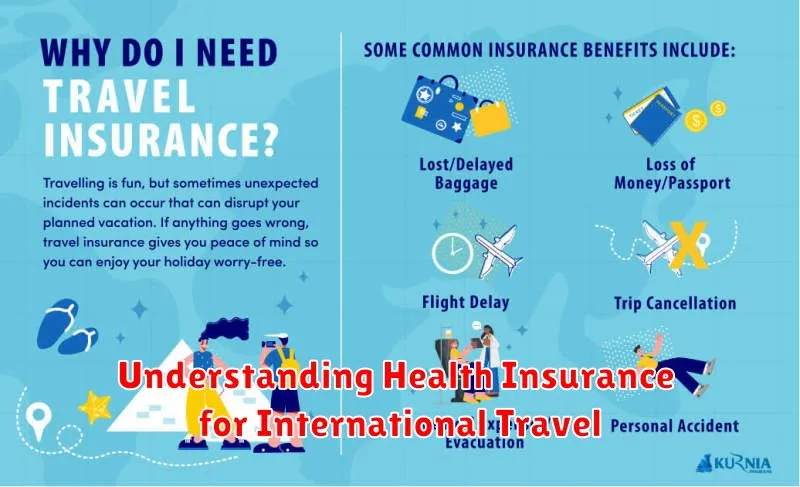Planning international travel? One of the most crucial aspects of a safe and worry-free trip is securing comprehensive health insurance for international travel. Understanding the nuances of international travel insurance can be daunting, but it’s an essential investment that can protect you from unforeseen medical expenses, emergencies, and other travel-related disruptions. This article will delve into the essentials of health insurance for travelers, covering key aspects like coverage options, policy types, and selecting the right plan for your specific needs. Whether you’re embarking on a short vacation or a long-term adventure abroad, understanding your international health insurance options is paramount.
Navigating the world of travel health insurance can feel overwhelming, but with the right information, you can make informed decisions that provide peace of mind throughout your journey. From understanding the differences between travel medical insurance and international medical insurance to comprehending essential coverage elements like medical evacuation and repatriation, this guide will empower you to select the best international travel insurance plan for your individual circumstances. Don’t let unexpected health issues derail your international travels – equip yourself with the knowledge you need to stay protected and enjoy your trip to the fullest.
Why Regular Insurance Doesn’t Always Work Abroad
Your regular health insurance plan likely offers limited or no coverage outside your home country. International travel introduces unique healthcare needs and costs that standard plans aren’t designed to handle.
Many domestic plans exclude care received from foreign hospitals and doctors. This means you’d be responsible for the full cost of treatment, which can be significantly higher in some countries.
Furthermore, emergency medical evacuation, a crucial service if specialized care is needed after an accident or sudden illness, is rarely covered by standard insurance. These evacuations can be extremely expensive.
What Travel Health Insurance Covers
Travel health insurance offers essential coverage for unforeseen medical events during international trips. Policies typically cover emergency medical expenses, including hospital stays, doctor visits, and prescribed medications.
Many plans also include coverage for medical evacuation, should a higher level of care be required. Additional benefits can include coverage for trip interruption, lost baggage, and repatriation.
Emergency Evacuation and Medical Transport
Emergency evacuation coverage is crucial for international travel. It provides medically necessary transportation to the nearest adequate medical facility if local treatment is insufficient. This often involves air ambulances or other specialized transport.
Medical transport covers the cost of transferring you to a medical facility near your home after you’ve been stabilized. This can be particularly important if you’re hospitalized far from home.
Ensure your policy clearly defines the conditions for evacuation and repatriation, including coverage limits and any required pre-authorization.
Finding Doctors in Network

Locating in-network medical providers abroad can be crucial for maximizing your insurance benefits and minimizing out-of-pocket expenses. Start by contacting your insurance company directly, either through their website or customer service line. They can typically provide a list of approved providers in your destination country.
If your insurer doesn’t offer a comprehensive directory, consider using a global provider search tool, if available. Many insurers partner with international networks that facilitate finding in-network doctors and hospitals worldwide.
Understanding Claim Processes
Understanding the claim process for your international travel insurance is crucial. Generally, you’ll need to gather all necessary documentation, including your policy information, medical bills, and possibly a claim form.
Filing a claim typically involves contacting your insurance provider directly or through their online portal. Provide all requested information accurately and promptly to expedite the process.
Reimbursement processes vary. Some providers offer direct billing where they settle with the medical facility, while others reimburse you after you’ve paid the expenses upfront.
Knowing What’s Excluded
Understanding exclusions is crucial when selecting international travel insurance. Common exclusions include pre-existing conditions, extreme sports injuries, and expenses related to pregnancy or childbirth.
Carefully review your policy documents to understand the specific exclusions and whether supplemental coverage is needed to address your individual needs. Certain high-risk activities may require separate specialty insurance.
Comparing Short vs Long-Term Plans
When selecting international travel insurance, a crucial decision revolves around the duration of coverage. Short-term plans are designed for brief trips, offering coverage for a specific period, often up to a few months. These are typically more affordable for shorter durations.
Long-term plans cater to extended stays abroad, such as a year or more. While generally more expensive overall, they provide continuous coverage for the entire duration of your trip. This is particularly important for those working, studying, or residing abroad long-term.
Consider the length of your travel as the primary factor when deciding between short-term and long-term coverage. Other factors include your destination, activities planned, and overall budget.

